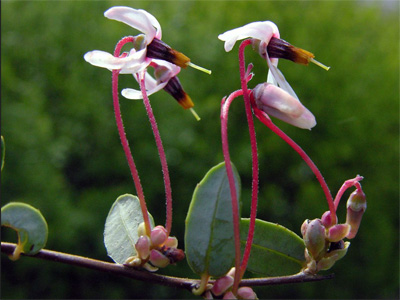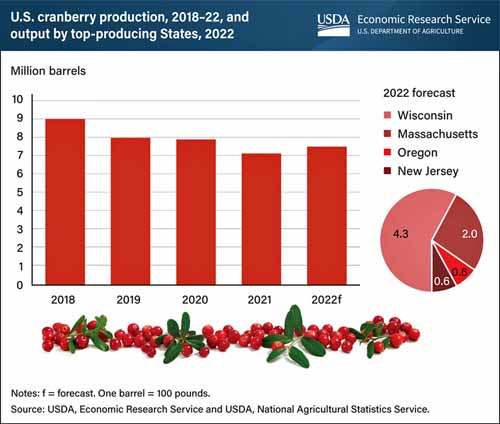Friends of Myles Standish State Forest
East Head Reservoir Eco Tour

Cranberry

Water and the Cranberry (Vaccinium macrocarpon
)Created in 1868, the water of East Head Reservoir are not for drinking, but for use on nearby cranberry bogs that are irrigated throughout the growing season. In early autumn, water released from here is used to flood the bogs for harvesting.
About fifteen million years ago a new genus of plants Vaccinium (V.) evolved, that thrived in acid sands. By ten million years ago this genus had evolved many new species including the cranberry, V. macrocarpon and the blueberry,V.corymbosum and today hundreds of other V. species have evolved.
The name "cranberry" derives from the Pilgrim name for the fruit, "craneberry", so called because the small, pink blossoms that appear in the spring resemble the head and bill of a crane.
“Crane Berry Flowers” - pinterest

What’s the Buzz: The Bees Knees
Pollination may occur by bats, bees, beetles, birds, butterflies, moths and wasps. But native bumble bees are the bees knees. For they are just big enough and wobble just the right way to afford the best pollination. Perhaps it is because these companion species evolved together.
Seed Dispersal
Unlike cranberries, most fruit depends on animals to spread their seeds. That means that selective pressure made the fruits sweeter and sweeter. However, cranberries, which use mostly water for seed dispersal, had no such selective pressure and thus remained sour. In spite of this many animals brave the berry. While cranberries (like most plants) are 90% water, they do not grow in water. In fact, cranberries float because they have small air pockets that trap air. Cranberry bogs are flooded in the fall, the berries are shaken loose and float in the water, then skimmed of the top of the bog. Harvest season is October to December. During this time watch for bogs that are cranberry red.
Cranberry Production by State

While Massachusetts produces about 21% of the nation’s cranberries, the town of Carver alone produces about 10%.
Winter Flooding
When frigid weather is forecast Cranberry bogs may be flooded in the winter, then the frozen cover protects the plants from the dehydrating wind chill.
- 44 calories per cup
- 440 cranberries in a pound
- 4,400 cranberries in a gallon of juice
- 440,000 cranberries in a barrel
- 440,000,000 cranberries are eaten each year (almost)
Health
Studies have shown that cranberries offer many health benefits. Some studies have shown that cranberries inhibit tumor progression and other studies show a reduced the risk of cardiovascular diseases. But the major benefits are in preventing the urinary tract infections (UTI).
Urinary Tract Infections (UTI's)
Research (Gabrielle Williams, in The Cochrane Review, April 2023) shows that cranberry products:
“reduce the risk of repeat symptomatic UTIs in women by more than a quarter, in children by more than half, and in people susceptible to UTI following medical interventions by about 53%”.
The mechanism of actions is not clear. Some studies show that cranberries turn the urine more acidic, which inhibits the growth of Escherichia coli. While another spate of studies are on-going to test whether cranberries inhibit a bacteria's ability to bind to the urinary tract. Competing theories are that cranberry compounds make urinary tract too slippery to bind to, or that a cranberry compound changes the bacteria’s ability to bind.
The cranberry was used by native Americans in poultices and as a red dye. They also mixed deer meat with cranberries (Pemmican) giving a long lasting source of protein and fruit.
Forest Community
Many birds eat cranberries including, cardinals, woodpeckers, titmice, blue jays and nuthatches.
Deer often visit bogs. In fact, deer may eat 3 or 4 barrels of cranberries per bog. Deer also may trample vines and even bed down in the bog. Burrowing animals such as muskrats, voles, and woodchucks may damage infrastructure. Growers work toward pest control with owl and kestrel bird boxes, by providing perches fro raptors and finally by preserving nearby fox and coyote dens.
300% increase in production! Have you seen the bogs being made over?
Nickolai Vorsa, Rutgers Professor of Plant Biology, spent his career studying cranberries. He was instrumental in the sequencing of the cranberry genome, as well as identifying genes for flavor, acidity and disease resistance. His program patented and released seven new cranberry varieties with a 300% increase in production of sweeter fruit. When local growers need to redo their bogs for any reason they probably use Vorsa’s varieties.
All line drawings by: Patricia J. Cassidy